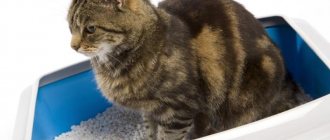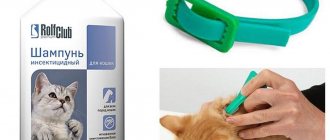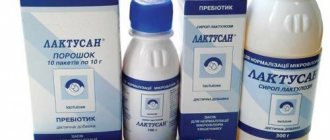Signs
Constipation in a dog cannot be considered a situation when the dog does his business perfectly well, but not according to the standard 1-2 times a day, but maybe once every 2 days. But at the same time, the process of excreting feces is not difficult, there are no symptoms of malaise, the pet is cheerful and healthy.
Constipation is not a disease or a breed trait; a symptom of problems with defecation can be in small dogs (York, Pug, Pekingese, Spitz, Chihuahua) and large ones (Alabai, black terrier, St. Bernard, etc.).
What is considered constipation and when veterinarians recommend going to the clinic:
- If there is pain during defecation and stool no more than 2 times every three days, then you should visit a veterinarian.
- With constipation, dry feces accumulate in the intestines, they injure the mucous membrane and become an additional reason for the lack of bowel movements. It hurts the dog when they begin to move through the intestines and through the anus. She instinctively contracts the sphincter, causing constipation.
- In older pets, the problem of constipation is especially acute due to the natural weakening of the gastrointestinal tract tone. An unbalanced diet, regardless of age and physiological condition, causes difficulty in defecation.
Treating a pet for constipation at home is only permissible if there are no life-threatening conditions. It is necessary to exclude a number of diseases that manifest themselves as constipation as one of the symptoms. Only a veterinarian can do this reliably.
Symptoms
Does your dog often get constipated?
First
74.71%
Periodically
21.84%
Often
3.45%
Normally, a dog has bowel movements 1-3 times a day. Sure signs of constipation are the absence of bowel movements for 2 days.
The frequency of relief depends on the type of feeding. Dogs on economy and premium food go to the toilet more often, because... The products contain a lot of grain ingredients that are poorly digestible. When fed super-premium and holistic brands, pets defecate less frequently.
If the pet is kept on a natural diet with a high meat content, defecation is allowed once every 2 days.
The first symptoms are the dog's anxiety. If she sits down and pushes, but to no avail, they speak of coprostasis or constipation.
Symptoms of constipation in dogs are also characterized by:
- pain during defecation - hard feces scratch the intestinal walls, possible admixtures of bright scarlet blood;
- small volume of stool;
- difficult bowel movements;
- hard, dark, dry stool;
- squealing or whining due to pain.
Vomiting is another sign of constipation in dogs. When feces accumulate, the body becomes intoxicated. Also, coprostasis with nausea indicates intestinal obstruction.
The owner can independently determine constipation by palpating the lower abdomen. There will be elongated soft lumps behind the abdominal wall.
Main reasons
Almost always, the breeder associates the manifestation of symptoms of constipation with a feeding disorder; in 70% of cases this is a correct assumption. But veterinarians are less optimistic; in some cases, the reasons point to physiological pathologies that cannot be eliminated only by an enema of oil or Vaseline.
wrong diet
There are two types of owners - those who are obsessed with the dog’s nutrition, create “glamorous” diets for it and pester the veterinarian with endless proposals for introducing new (often not dog) foods into the diet. Others rightly believe that a dog is akin to a waste bin, which can be used to dump everything into a bowl: from raw potato peels to moldy bread. There are even individuals who feed domestic dogs with compound feed for pigs and cows (village practice). The most common problems: eating waste, a small amount of fiber (no volume of feces), dry food and lack of water, monotonous diet, overfeeding.
Bones are dangerous for dogs! Every breeder should remember this. Contrary to the belief that dogs eat bones, they should not be used as food. Especially when it comes to chicken bones, boiled beef and pork fragments after soup, and small flat ribs. In the archives of any practicing doctor there are many cases where an animal died on the operating table without waiting for the end of the surgical intervention. Kilograms of compressed bones in the stomach and intestines not only create constipation, but also pose a direct threat of death from damage to the integrity of the gastrointestinal tract with sharp edges and the development of peritonitis.
Dehydration
Poor wetting of the food bolus and its excessive dryness leads to the formation of dense feces in the intestines. Their progress is difficult; when trying to defecate, the dog strains strongly, and blood may appear.
Physical inactivity (little movement) and obesity
In dogs that spend most of their lives in conditions of limited mobility, the functioning of the gastrointestinal tract is disrupted. Digestion and movement of food through the intestines is complicated due to obesity.
If your pet doesn't get enough outdoor exercise and doesn't run, jump, or play, constipation may develop. Promotion of a food coma is difficult.
Taking certain medications
Incorrect dosage (for example, iron-containing drugs) can cause constipation. As a side effect, constipation occurs with long-term use of anti-diarrhea medications.
Constipation as a symptom of anxiety
Veterinarians note pathologies in which constipation may develop:
- Diseases of the liver, kidneys, gastrointestinal tract.
- Inflammatory processes, abscesses and swelling of the prostate, paraanal glands.
- Skeletal injuries in the pelvic area.
- Mechanical blockage (bone or any foreign object).
The cause of blockage can be a clump of worms with extensive helminthic infestation or tumor.
Dangerous conditions that provoke constipation are volvulus, intestinal atony, diseases of the central nervous system and, as a result, paralysis and paresis, spinal injuries.
Causes of constipation in dogs
Four-legged friends can feel discomfort for a long time without making a sound, and only the attentive attitude of the owners will help determine that the dog has not relieved itself properly for some time. And since this phenomenon occurs quite often, it is worth knowing in advance about the actions necessary in this case. How can you provide quick help without harming the dog?
Some pet owners, without even thinking too much, give them conventional medications intended to relieve constipation in humans. Experts strongly recommend not to do this, because a dog’s body is structured in a slightly different way than a human’s.
What can cause indigestion leading to constipation? It is worth considering the most common options:
- Errors in nutrition . Boiled bones, especially in large quantities, a sharp change in diet - from natural to dry or vice versa, insufficient amounts of plant fiber in food - contribute to the development of constipation. Frequent feeding of foods that strengthen the intestines also provokes difficult bowel movements.
- Lack of water . Experts recommend organizing a timely drinking regime for your pet. In addition, it is necessary to monitor the freshness of the water by replacing the liquid daily, as many dogs will not drink stagnant water and will suffer from thirst. Pets' drinking consumption increases during hot weather, intense physical activity, and feeding with dry food. If the animal does not have enough water, the body begins to use the liquid that is in the large intestine, thus dehydrating the feces, making them hard and dry.
- Parasites . Worms and other parasitic organisms often damage the intestinal walls, thereby disrupting the absorption of nutrients and liquids, which leads to a malfunction of the intestines.
- Getting wool into the gastrointestinal tract . If this happens regularly, entire hairballs can form in the intestines, leading to constipation. Of course, this is most often a problem with cats, but it can also occur in dogs that lick themselves.
- Chronic diseases . In most cases, the intestines are affected by diseases of the genitourinary system - in males it is prostatitis, in females it is inflammation of the uterus and appendages, as well as inflammatory processes in the anal glands.
As you can see, there can be quite a few reasons, and based on them, it is worth choosing a suitable laxative for your dog.
Why is it dangerous?
The danger of constipation is obvious - any disturbance in the functioning of the body is fraught with an increase in problems like a snowball. The dog needs urgent help by quickly eliminating both the cause and effect of the blockage.
List of negative consequences:
- General intoxication of the body. Removing feces is a method of cleansing the body of excess ballast; when this does not happen, decay products, toxins and other elements begin to be absorbed into the blood, poisoning the animal’s body.
- Internal organ injury. Dry, dense feces, especially with bones or a foreign object, can injure the intestines until they rupture and release the contents into the abdominal cavity. The result is peritonitis and the death of the pet.
- Disruption of internal systems and organs. The body of any living creature, including a dog, is like a well-oiled mechanism where there is nothing superfluous. When even a tiny cog falls out of a physiological process, a failure occurs, the consequences of which are unpredictable.
Systematic constipation puts a serious strain on the cardiovascular system, visually manifesting skin problems with scratching, itching, and baldness. Prolonged constipation (4-7 days) almost always ends in the death of the dog.
Why does a dog get constipated?
Causes of constipation can be:
- dietary errors (low fiber, “sugar” bones);
- ingestion of foreign bodies (including fur and hair, which form lumps in the animal’s gastrointestinal tract
- pilobesoars);
- lack of physical activity;
- obesity;
- enlarged prostate gland in males;
- pelvic fracture;
- neoplasm or rectal hernia;
- diseases of the kidneys, liver, pancreas;
- orthopedic problems;
- diseases of the paraanal glands.
Older, overweight dogs are especially prone to constipation.
When to go to the clinic
What to do if such a problem is discovered, and when should you contact the clinic? Or can the problem be solved at home? This is judged by the following characteristic features:
- frequent urge and difficulty defecating;
- a small amount of hard, crumbly or dense pellets:
- restlessness, whining, fidgeting in one place, the dog cannot find a comfortable place to rest;
- pain when trying to defecate;
- severely swollen belly from gas.
Any malaise is accompanied by depression, apathy and lack of appetite. Games and the desire for walks become unacceptable, the pet loses interest in the world around him.
You can independently distinguish the accumulation of feces in the rectum from complete intestinal obstruction. To do this, you need to penetrate the anus with a finger (wearing a medical glove), lubricated with oil (preferably sea buckthorn) or Vaseline to make sure the presence/absence of feces.
Vomiting and constipation are a very dangerous combination, indicating a complete blockage of the intestines. You cannot use laxatives or folk remedies at home (oil, sweet water, vegetable or fish oil, etc.), help must be provided immediately, the risk of the dog’s death is very high!
How to treat a dog
In many cases, to treat constipation, the use of laxatives is sufficient: petroleum jelly (precisely petroleum jelly, sunflower, olive and, especially, castor oil should never be given!), lactulose preparations (Duphalac, Lactusan).
In cases of significant and long-standing accumulation of dense stool in the large intestine, a deep enema may be required under general anesthesia.
Rarely, surgery is required (eg, for megacolon, masses, or foreign objects).
If the dog's general condition is unsatisfactory, hospital stay and infusion therapy may be required.
It is also necessary to examine for concomitant diseases of internal organs.
Information for the doctor
You can quickly cure a dog if you take your pet to the doctor on time or call a specialist at home, tell him all the existing points to complete the medical history and make a correct diagnosis.
What needs to be said:
- age, lifestyle;
- how much time has passed since the last bowel movement;
- when constipation could occur;
- what conditions preceded the formation of constipation;
- food list for the last two days;
- diet, frequency, volume;
- whether there was vomiting or injury.
Be sure to report to the doctor about changes in your pet’s behavior, whether there was defecation or the urge to defecate, the presence of appetite, or thirst. We must not forget about the possibility that the dog ate a foreign object (bone, ball, rag, etc.).
Additional methods:
- abdominal x-ray;
- general blood analysis;
- X-ray of the intestine with contrast to assess the degree of its patency;
- Ultrasound of the abdominal cavity.
During the examination, the veterinarian will determine the presence/absence of blockage, inflammation, neurological diseases and problems in the anus or paraanal glands in the intestines.
What information should dog owners provide to the treating veterinarian?
When contacting your veterinarian, it is important to provide the following information in more detail:
- the age of the animal and lifestyle;
- when constipation was discovered and how it manifested itself;
- whether the dog has vomited, its frequency and frequency, the type of vomit;
- usual methods and daily frequency of feeding;
- a list of food fed over the last 24 hours;
- changes in behavior, urination, defecation, appetite, thirst.
During a clinical examination of a sick dog, a veterinarian can determine the presence of foreign objects in the intestines, the presence of inflammation of the perineum and anus, problems with the paraanal glands, neurological problems, injuries to the pelvic bones and spine.
To more accurately determine why a dog is constipated, the following may additionally be prescribed in a veterinary clinic:
- general blood analysis;
- abdominal x-ray;
- X-ray of the intestine with contrast to assess its patency;
- Ultrasound of the abdominal cavity.
Basics of helping your dog with constipation
At home, the owner can help his pet with coprostasis or the formation of excessively dry feces due to excessive absorption of water by the intestinal walls. This happens when feeding boiled bones or bone residue; the feces then acquire a whitish, chalky color and become hard.
You cannot buy bone scraps for your dog as protein food. This is nothing more than poorly ground chicken bones with veins and sharp edges. In essence, this is a time bomb and by feeding the bone residue, the owner deliberately destroys his pet.
If constipation is not accompanied by other symptoms of illness, you can take the following measures to help:
- Change your diet and water supply.
- Increase your walking time and physical activity.
- Use enemas and folk remedies.
- Give medications that increase peristalsis, improve digestion, and laxatives.
If there is severe discomfort during coprostasis, they give antispasmodics, laxatives, an enema, and normalize nutrition. Suppositories are used in the anus to heal microtraumas of the rectum.
It is important to start with an enema; if you give laxatives first, then dry feces will severely injure the anus and pain cannot be avoided.
A similar treatment regimen at home can be used by the breeder only for constipation that is not associated with internal diseases, bloat, swallowed foreign objects, etc. In other cases, you need the help of a veterinarian in a clinic setting.
Laxative for dogs
There are situations in which it is necessary to give a dog or puppy a special medicine so that he goes to the toilet. You need to understand that each specific situation may have its own characteristics of using such drugs and certain contraindications, so this article is for informational purposes only, and the prescription and choice of treatment for an existing health problem must be agreed upon with a veterinarian after examining the four-legged patient.
Also on the project you can find articles on other, no less interesting topics that will be useful to study for all lovers of such cute pets.
Laxative for dogs for constipation, poisoning at home
To combat constipation in dogs at home, you must first of all properly organize the animal’s nutrition and ensure that the four-legged pet’s body experiences sufficient physical activity. It is advisable to give food regularly, excluding fatty meat and increasing the amount of boiled vegetables.
Among the folk remedies for constipation, vegetable oil, crushed prunes and enemas can help. In case of poisoning, at home, dogs are given egg white diluted in half with water, liquid starch jelly, and activated carbon tablets. In addition, the animal is left without food for a day, giving only plenty of drink.
Prayers
Laxative for pet dogs and puppies of small and large breeds
The most common laxative for animals is vegetable oil.
To achieve a laxative effect, a medium-sized dog should be given 1-1.5 teaspoons of oil on an empty stomach in the morning; puppies and small breeds of animals should reduce the dose accordingly.
Large dog breeds are given vegetable oil at the rate of 1 tablespoon per 20 kg of animal weight.
Veterinarians may recommend Duphalac, Bimin or Microlax as a laxative.
Laxative for dogs after surgery
If after surgery the dog needs a laxative, then to solve this problem with medication, veterinarians resort to the use of antispasmodics - no-shpa and novocaine or baralgin.
Sometimes you can resort to folk remedies, giving the dog ordinary vegetable oil as a laxative (1 tablespoon per 20 kg of animal weight).
Laxative for dogs Bimin, Vaseline oil, description, reviews, where to buy, price
Vaseline oil and the drug "Bimin", made on its basis, are products that have a laxative effect.
Once in the animal's intestines, petroleum jelly envelops its walls and promotes the movement of solid feces and other inclusions (fur, foreign bodies, etc.).
Owners of animals suffering from constipation speak positively about these drugs.
"Bimin", compared to petroleum jelly, has a gentler effect, so many veterinarians recommend giving this remedy to relieve constipation in dogs during the postoperative period.
You can purchase these medications at any veterinary pharmacy or online.
Add a comment Cancel reply
Procedure for using an enema
If the dog owner does not have the skill to use an enema, it is better to call a veterinarian at home. It is difficult to handle a pet without the appropriate skill; it can cause serious harm or cause injury.
Enema solutions:
- Vaseline oil.
- Soapy or glycerin water.
- Boiled water, warm.
- Water with fish oil.
There are certain volumes of liquid dosed according to the dog’s weight: up to 50 kg - approximately 1 liter, from 20 to 40 kg - up to 500 ml, up to 20 kg - no more than 200 ml. The smaller the dog, the smaller the volume of liquid in the enema should be.
For large breeds of dogs, use an Esmarch mug, hanging it at a height of 70 cm -1 m, and large syringes. For dwarf breeds, syringes of 10-20 cubes are suitable. All devices must have rubber tips.
For relaxation and pain relief, No-shpa or Baralgin (0.1 ml/kg body weight) is administered intramuscularly before the procedure.
List of medicines and folk remedies
The following list of medications for constipation can be used at home, but veterinarians do not recommend giving them without consulting a doctor, as there is a risk of misdiagnosis and worsening the situation.
Medicinal
List of drugs:
- Magnesia. Increases the flow of fluid into the intestines, dilutes feces, stimulates peristalsis. It is not allowed for pathologies of the heart, kidneys, or gall bladder.
- Duphalac, Lactusan. Contains lactulose, helps increase the volume of feces, is not absorbed, enhances peristalsis.
- Bisacodyl. Strengthens the secretion of mucus in the intestines, stimulates peristalsis. The release form is convenient for dogs - suppositories (or tablets).
- Vetelak. The veterinary preparation contains lactose, lactulose and galactose, which gives a pronounced laxative effect, attracts water and is effective for severe constipation.
- Laxatone. The paste is more intended for removing bezoars (hairballs from the intestines), improves peristalsis.
- Vetasil. Dietary supplement, consists of 100% barley and plantain.
Laxatives should not be given to pregnant or malnourished animals, or if there are obvious problems (except constipation) in the gastrointestinal tract, the presence of foreign bodies or intussusception. The period of use and dose are indicated in the instructions.
Folk
It is permissible to help your dog at home using folk remedies.
Kefir is given at night from 40 ml to 200 ml depending on the size of the pet. If the animal does not want to drink on its own, kefir is poured in with a syringe or syringe.
Castor, flaxseed, vegetable or sea buckthorn oil. Give water according to your pet’s weight (from 2 to 7 tbsp) using a syringe or add it to food with evening feeding. A laxative effect is expected after 5-8 hours.
Vaseline oil is given in a dose of 5-80 ml (by weight) using a small syringe or syringe. Give every 12 hours until the result, the oil envelops the feces and gently removes them. Sometimes used as a microenema when heated.
How to distinguish constipation from intestinal obstruction?
When self-diagnosing the disease, it is important to be able to identify constipation in a dog and distinguish it from intestinal obstruction. Only in some cases, intestinal necessity and constipation are identical concepts, for example, if the disease developed against the background of intestinal blockage by a foreign object.
A more serious problem than constipation is a complete blockage or volvulus of the intestine. The most common cause of complete blockage of the small intestine is eating cellophane, such as sausage casings or crab sticks.
Important! Volvulus is a very serious condition that affects many active dogs.
General rules for keeping dogs do not recommend walking animals immediately after feeding, since activity on a full stomach can overlap a fragment of the intestine. Intestinal overlap leads to rapid tissue death, necrosis and sepsis. The condition is fatal, and the clinical picture develops in a matter of hours. The problem can only be solved surgically, and you cannot wait and watch.
The main differences between intestinal volvulus and constipation are the rapidity of development of the clinical picture. Constipation accompanies intestinal blockage, but is not the first indicative symptom. Before you realize that your dog has problems with bowel movements, there will be a decrease in body temperature, pale mucous membranes, severe abdominal pain, bad breath, irregular heart rhythm, general weakness and apathy.
If you doubt the correctness of the diagnosis, it is necessary to take an x-ray with a contrast agent. Typically, barium is used to make images, which is poured into the animal's mouth before radiography. By the glow of barium in the image, the naked eye can see how passable the intestines are, in which part of it there is a blockage and how filled it is with feces.
Features of puppy treatment
A common cause of constipation in a puppy is trichobezoars, hairs that have been swallowed and compressed in the intestines. Their danger is that if they are not removed in a timely manner, bezoars grow into the walls of the digestive tract, forming a serious obstruction with damage to the inner lining of the intestine. Surgery will be required to remove them.
Constipation in a puppy can develop for standard reasons that are also present in adult dogs.
Newborn puppies experience constipation when their tummies are not properly massaged. When artificial feeding, the massage should be carried out by the breeder, imitating the movements of the mother dog's tongue. Help in stimulating digestion is required with a large litter, when the animal does not have time to cope on its own.
For trichobezoars in puppies, treatment is prescribed by a veterinarian after an x-ray or ultrasound. An examination is necessary to determine the location of the hairball and its size. If he can leave the intestines with the help of laxatives and drugs that enhance peristalsis, then treatment consists of giving these drugs.
If the trichobezoar is large and has a dense blockage of the intestine, surgery is performed.
It is not recommended to give a puppy an enema yourself, especially mini-breed puppies. The walls of the rectum are so thin and small that it is not difficult to damage them. Use a small medicinal pear and a warm chamomile decoction.
Causes
Intestinal blockage in dogs occurs as a result of a wide variety of factors. The most common causes of pathology are:
- stones, rags, bones and other hard objects swallowed by the dog;
- hairballs (applies to dog breeds with long hair);
- formation of bezoars in the intestine;
- torsion and intussusception of intestinal loops;
- problems with secretion and motility functions (changes in peristalsis).
Most often, veterinarians diagnose intestinal blockages in patients as a result of solid foreign objects entering the digestive tract. These can be laces and rags, chips from sticks, small stones.
They clog the lumen of the small intestine, causing inflammation and stagnation of food passage. A serious obstacle arises to the normal movement of feces to the exit. This type of blockage develops quickly.
There is a slower development of intestinal obstruction, which occurs against the background of hair entering the gastrointestinal tract and its further accumulation until a critical moment. The cause of slowly developing intestinal blockage can be diseases of the internal organs.
Pinching of intestinal loops, torsion and intussusception, conditions accompanied by severe pain in the animal in the peritoneal area. Colic can be constant or occur periodically. The main causes of torsion, intussusception or entrapment are changes in motor function (hyperactivity), decreased elasticity and weakening of the ligaments that support the intestinal loops.
Constipation in dogs is closely related to the development of intestinal blockage or obstruction. Constipation is a process of impaired stool ejection or complete absence of stool. The causes of chronic constipation in dogs include poor diet, sedentary lifestyle, and stress.
Taking certain medications can provoke constipation and the development of blockage of the large intestine with feces. They have a pronounced effect on intestinal motor function and also reduce the production of specific secretions. In some cases, obstruction occurs when the nervous system is damaged. These are mainly damage to the cerebellum and spinal cord.
Find out more about what to do if your dog swallows a foreign body>>>
What to feed your dog
If constipation is a fait accompli, then you need to first rid your pet of it, and then adjust the diet. Large meals and physical activity are contraindicated.
To prevent constipation in the future, the following is included in the diet:
- porridge with water or low-fat milk;
- stewed, boiled vegetables;
- sea fish (boiled fillet);
- dairy products;
- cabbage juice (not allowed if there is increased gas formation);
- plums (prunes – 2 pcs.).
The usual diet for a domestic dog is porridge with meat, you can add vegetables and a spoonful of butter. Not bad for digestion - beef tripe, unpeeled, but well washed. The gray, fleecy “skin” contains microorganisms that help the dog with digestion.
Absolutely no: rich broths, cheese, economy-class dry food, fatty foods, bones, pastries and table food.
General prevention
Rather than treating constipation, it is better to avoid it, every breeder should know this. Prevention is based on eliminating all causes that can provoke this problem. In the absence of internal pathologies of the gastrointestinal tract and diseases that are accompanied by constipation, it is necessary:
- Remove small (especially chicken) bones from the diet.
- Give only raw, beef and large moles.
- You cannot feed skins from farm animals.
- Diversify your diet by adding vegetables, fruits, and cereals.
- Carry out deworming (giving anthelmintic drugs).
- Walk 2-3 times a day.
Water must be constantly, fresh and freely available. Make sure your pet does not swallow inedible objects.
Do not forget that sometimes a dog cannot go to the toilet due to the banal lack of feces due to insufficient feeding of the pet.











